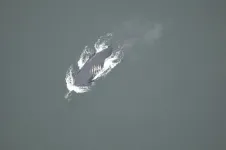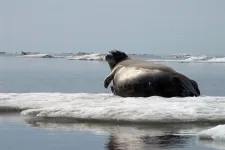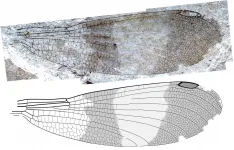What to do when a mammogram shows swollen lymph nodes in women just vaccinated for COVID
Radiologists offer an approach to avoid confusion among patients and clinicians
2021-02-24
(Press-News.org) BOSTON - Swelling of lymph nodes in the armpit area is a normal response to COVID-19 vaccinations, but when they are seen on mammograms, they can be mistaken for nodes that are swollen because of cancer. In some cases, the nodes are biopsied to confirm they are not cancer. To avoid confusion by patients and their providers, and to avoid delays in either vaccinations or recommended mammograms through the pandemic, radiologists at Massachusetts General Hospital (MGH) have published an approach to manage what is expected to be a fairly common occurrence as vaccination programs ramp up. The approach is described in the American Journal of Roentgenology.
"We had started to see more patients in our breast imaging clinic with enlarged lymph nodes on mammography, ultrasound, and magnetic resonance imaging. And we noticed they were coming to our clinic after a recent COVID-19 vaccination," explains lead author Constance Lehman, MD, PhD, director of Breast Imaging and co-director of the Avon Comprehensive Breast Evaluation Center at MGH. "We talked with our colleagues in primary care and in our breast cancer specialty clinics and realized we needed a clear plan for management."
The team's goals were to develop a program that supported patients to continue to engage in vaccination programs while also ensuring that patients continued to receive their routine health care needs, such as breast cancer screening. It was also important to reassure patients that swollen lymph nodes in the armpit is a normal and expected finding after vaccination.
The group's approach is based on three principles: 1) encouraging COVID-19 vaccination; 2) reducing and/or eliminating delays, cancellations, and rescheduling of breast imaging exams; and 3) reducing unnecessary additional imaging and/or biopsies of lymph nodes that have become swollen from recent vaccination.
"In addition to avoiding delays in vaccinations and breast cancer diagnoses, we hope that our model will reduce patient anxiety, health care provider burden, and costs of unnecessary evaluations of enlarged lymph nodes after vaccinations," says Lehman.
Lehman and her colleagues--including co-authors Leslie Lamb, MD, MSc, and Helen Anne D'Alessandro, MD--stress that no additional imaging tests are needed for swollen lymph nodes after recent vaccinations unless the swelling persists or if the patient has other health issues. This message should be communicated to both imaging staff and patients. Patient letters may read: "The lymph nodes in your armpit area that we see on your mammogram are larger on the side where you had your recent COVID-19 vaccine. Enlarged lymph nodes are common after the COVID-19 vaccine and are your body's normal reaction to the vaccine. However, if you feel a lump in your armpit that lasts for more than six weeks after your vaccination, you should let your health care provider know."
Lehman notes that drastic declines in screening mammography and breast cancer diagnoses are well documented across multiple health care institutions due to the COVID-19 pandemic. "This disruption of breast cancer screening is likely to result in a significant increase in cancers diagnosed at late stages and an increased demand for cancer screening procedures as delayed tests are rescheduled," she says. "We believe our model can avoid reducing or delaying vaccinations and avoid further reduced or delayed breast cancer diagnoses based on confusion amongst patients and/or their providers."
INFORMATION:
About the Massachusetts General Hospital
Massachusetts General Hospital, founded in 1811, is the original and largest teaching hospital of Harvard Medical School. The Mass General Research Institute conducts the largest hospital-based research program in the nation, with annual research operations of more than $1 billion and comprises more than 9,500 researchers working across more than 30 institutes, centers and departments. In August 2020, Mass General was named #6 in the U.S. News & World Report list of "America's Best Hospitals."
ELSE PRESS RELEASES FROM THIS DATE:
2021-02-24
A new study from North Carolina State University reveals that the soundscapes of coral reef ecosystems can recover quickly from severe weather events such as hurricanes. The work also demonstrates that non-invasive monitoring is an important tool in shedding further light on these key ecosystems.
Soundscape ecology is a relatively new way for researchers to keep tabs on a variety of habitats without direct interference. In underwater habitats like coral reefs, soundscapes allow continual monitoring of an ecosystem that is difficult to access. By deploying underwater microphones, or hydrophones, researchers can get an acoustic picture of the types of animals in the ecosystem, as well as their behavior patterns.
Kayelyn Simmons, a Ph.D. student at NC State, used soundscapes and ...
2021-02-24
NASA's Parker Solar Probe captured stunning views of Venus during its close flyby of the planet in July 2020.
Though Parker Solar Probe's focus is the Sun, Venus plays a critical role in the mission: The spacecraft whips by Venus a total of seven times over the course of its seven-year mission, using the planet's gravity to bend the spacecraft's orbit. These Venus gravity assists allow Parker Solar Probe to fly closer and closer to the Sun on its mission to study the dynamics of the solar wind close to its source.
But -- along with the orbital dynamics -- these passes can also yield some unique and even unexpected views of the inner solar system. During the mission's third ...
2021-02-24
Evolutionary expert Charles Darwin and others recognized a close evolutionary relationship between humans, chimps and gorillas based on their shared anatomies, raising some big questions: how are humans related to other primates, and exactly how did early humans move around? Research by a Texas A&M University professor may provide some answers.
Thomas Cody Prang, assistant professor of anthropology, and colleagues examined the skeletal remains of Ardipithecus ramidus ("Ardi"), dated to 4.4 million years old and found in Ethiopia. One of Ardi's hands was exceptionally well-preserved.
The researchers compared the shape of Ardi's hand to hundreds of other hand specimens representing recent humans, apes and monkeys (measured ...
2021-02-24
A study co-authored by scientists at the New England Aquarium has found that known deaths of critically endangered North Atlantic right whales represent a fraction of the true death toll. This comes as the death of a calf and recent sightings of entangled right whales off the southeastern United States raise alarm.
The study, published this month in END ...
2021-02-24
Ithaca, NY-- During mating season, male bearded seals make loud calls to attract a mate--even their "quiet" call could still be as ear-rattling as a chainsaw. Bearded seals have to be loud to be heard over the cacophony of their equally loud brethren. And, increasingly, the noise humans make is adding to the underwater din and could have serious consequences. A study conducted by the Cornell Lab of Ornithology's Center for Conservation Bioacoustics (CCB) aims to understand how resilient bearded seals can be to changes in ambient underwater noise. The results are published in Proceedings of the Royal Society: Biological Science.
"We wanted to know whether bearded seals would call louder when ...
2021-02-24
Researchers at Stevens Institute of Technology have developed a new machine learning-powered platform, known as OC-SMART, that can process ocean color in satellite images 10 times faster than the world's leading platform. The work, which will be adopted by NASA, is one of the first machine learning-based platforms in ocean color analysis that can process both coastal and open ocean regions globally to reveal data on sea health and the impact of climate change.
The work, led by Knut Stamnes, a physics professor at Stevens, and spearheaded by Yongzhen Fan Ph.D. '16, a visiting physics scholar in Stamnes' lab, solves a 30-year-old problem in retrieving data from both coastal regions and open ocean areas. For decades, NASA's SeaDAS platform exceled at analyzing ocean color ...
2021-02-24
For more than 150 years, scientists have been incorrectly classifying a group of fossil insects as damselflies, the familiar cousins of dragonflies that flit around wetlands eating mosquitoes. While they are strikingly similar, these fossils have oddly shaped heads, which researchers have always attributed to distortion resulting from the fossilization process.
Now, however, a team of researchers led by Simon Fraser University (SFU) paleontologist Bruce Archibald has discovered they aren't damselflies at all, but represent a major new insect group closely related to them.
The findings, published today in Zootaxa, show that the distinctive shape of the insect's non-protruding, ...
2021-02-24
When people hear botulinum toxin, they often think one of two things: a cosmetic that makes frown lines disappear or a deadly poison.
But the "miracle poison," as it's also known, has been approved by the F.D.A. to treat a suite of maladies like chronic migraines, uncontrolled blinking, and certain muscle spasms. And now, a team of researchers from Harvard University and the Broad Institute have, for the first time, proved they could rapidly evolve the toxin in the laboratory to target a variety of different proteins, creating a suite of bespoke, super-selective ...
2021-02-24
A Brazilian study published (http://www.nature.com/articles/s41467-020-20217-w) in Nature Communications shows that human activities have directly or indirectly caused biodiversity and biomass losses in over 80% of the remaining Atlantic Rainforest fragments.
According to the authors, in terms of carbon storage, the biomass erosion corresponds to the destruction of 70,000 square kilometers (km²) of forest - almost 10 million soccer pitches - or USD 2.3 billion-USD 2.6 billion in carbon credits. "These figures have direct implications for mechanisms of climate change mitigation," they state in the article.
Atlantic Rainforest remnants ...
2021-02-24
DALLAS - Feb. 24, 2021 - Using machine learning tools to analyze hundreds of proteins, UT Southwestern researchers have identified a group of biomarkers in blood that could lead to an earlier diagnosis of children with autism spectrum disorder (ASD) and, in turn, more effective therapies sooner.
The identification of nine serum proteins that strongly predict ASD were reported in a study published today by PLOS ONE.
Earlier diagnosis, followed by prompt therapeutic support and intervention, could have a significant impact on the 1 in 59 children diagnosed with autism in the United States. Being able to identify children on the autism spectrum when they are toddlers could make a big difference, says Dwight German, Ph.D., professor of psychiatry at UT Southwestern ...
LAST 30 PRESS RELEASES:
[Press-News.org] What to do when a mammogram shows swollen lymph nodes in women just vaccinated for COVID
Radiologists offer an approach to avoid confusion among patients and clinicians






